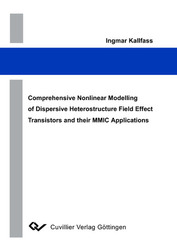| Departments | |
|---|---|
| Book Series (96) |
1378
|
| Nachhaltigkeit |
3
|
| Gesundheitswesen |
1
|
| Humanities |
2363
|
| Natural Sciences |
5406
|
| Engineering |
1791
|
| Engineering | 292 |
| Mechanical and process engineering | 861 |
| Electrical engineering | 686 |
| Mining and metallurgy | 30 |
| Architecture and civil engineering | 75 |
| Common |
97
|
|
Leitlinien Unfallchirurgie
5. Auflage bestellen |
|
Advanced Search
Compehensive Nonlinear Modelling of Dispersive Heterstructure Field Effect Transistors and their MMIC Applications (English shop)
Ingmar Kallfass (Author)Preview
Table of Contents, Datei (31 KB)
Extract, Datei (190 KB)
A custom HFET model was developed and applied in the design of several MMIC applica- tions. The model is expressly dedicated to microwave circuit design. Its analytical nonlinear equations provide a compromise between physical interpretability, numerical efficiency and global validity. As an essential part of the overall model, the COBRA expression features a highly efficient and accurate description of complex HFET drain current characteristics. A modification was introduced to include the reduction of drain current due to the self-heating effect as well as for improved description of gain compression. A new approach to frequency dispersion modelling extends the model’s validity range from the microwave- down to the low-frequency and DC regimes. The proposed dispersion model relies on conventional device characterisation techniques and standard parameter ex- traction procedures. The inclusion of multiple dispersion time constants and exponentially decaying step responses accurately reflects the physical nature of individual dispersion ef- fects, providing a correct description of transitions between dispersion regimes both in the time- and frequency domain. As a consequence, the model allows for accurate assessment of dynamic (gain, matching, intermodulation etc.), static (e.g. biasing, power consumption) as well as combined (e.g. PAE, self-biasing) figures of merit during the design phase. Addition- ally, the simulation error introduced by neglecting frequency dispersion when using purely static or dynamic drain current models, can be evaluated. A unified capacitance model approach defines the frame for sets of charge-conservative expressions for gate capacitance characteristics. The final equations employed here resemble in composition the Curtice IV model, e.g. in terms of transition from linear- to saturated- and from sub-threshold- to active voltage regimes. The universal validity of the model was demonstrated by applying it to several different HEMT technologies, encompassing both state-of-the-art GaAs pHEMT low-noise and power processes, high-frequency InP pHEMTs as well as novel concepts such as the strained-Si/SiGe mHEMT. Both the nonlinear capacitance and dispersion models proved to apply very well to all HEMT technologies.
| ISBN-13 (Printausgabe) | 3865379230 |
| ISBN-13 (Hard Copy) | 9783865379238 |
| ISBN-13 (eBook) | 9783736919235 |
| Final Book Format | A5 |
| Language | English |
| Page Number | 160 |
| Edition | 1 |
| Volume | 0 |
| Publication Place | Göttingen |
| Place of Dissertation | Ulm |
| Publication Date | 2006-06-28 |
| General Categorization | Dissertation |
| Departments |
Electrical engineering
|








